It makes a change for me, a northerner, to be writing about fishing in clear water, for our rivers, even when they’re low and ‘clear’ are not the same clarity as the southern chalk streams. But this year we’ve had our fair share of clear water conditions, and more to come, so it seems timely to write about dealing with them.
The best way to deal with crystal clear water is to fish at night, but that isn’t always an option for many anglers, so the following is aimed at those anglers who have no choice but to fish in the full glare of daylight.
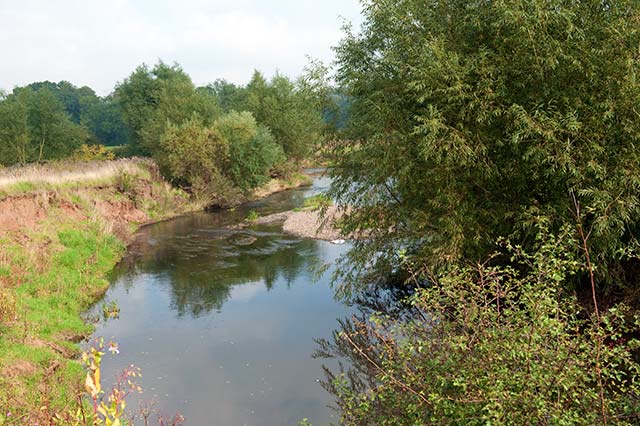
A low and clear River Dane
Many times the best answer is to choose deeper water with a good flow, and to pay particular attention to swims that lie in shade, beneath overhanging trees, for example. It’s true though that whatever tackle and bait we use it will be very clearly seen by the fish. This, of course, has its advantages as well as its disadvantages, in that the fish will be able to find what we’re offering them far more easily, and so we can appeal to their visual instincts far more than we normally can when the river is running with colour. It means that small baits can be seen from greater distances. For instance, maggot and caster trickling down the current is likely to be noticed by fish that are not swimming in that bait lane, simply because they can see it. So there is a chance, in that respect, that a constant trickle of bait through a swim will not only attract the fish that wander into the bait lane but those too that swim close enough to see the bait going by. ‘Close enough’ can be several yards in a clear river, rather than a few feet, or less, in a coloured one. Of course, clear water is a real bonus to the lure angler who is targeting fish that rely heavily on their visual abilities, and the roving angler who relies on spotting fish before he offers them a bait.
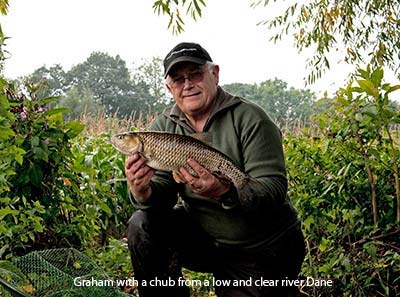
Anyway, you get my drift – clear water is not all bad news.
Although the positive aspect of clear rivers is that you can more easily spot the fish, the downside is that the fish can also spot an enemy more easily. An enemy being anything on the bank that moves and looks like it doesn’t belong there, ie, an angler, and anything in the water that doesn’t look natural and raises their suspicions to the point where they refuse to accept a bait. Which means we have to do one, or both, of two things: camouflage ourselves and the tackle, or make it less obvious.
Camouflaged Anglers
Although my personal preference in fishing clothing is for subtle greens and dark greys, I do occasionally wear a camouflage pattern jacket. It’s true though that many specialist anglers have now got themselves kitted out with full outfits of camouflage clothing and although this may look naff to some it does give you a distinct advantage when fishing clear water. There are times when you can’t fish a swim from behind cover, and it isn’t always practical to lie down and out of sight for the duration of a session, which is always the best option, so blending in with the background makes a lot of sense. The background in most instances is trees, bushes and other undergrowth, and there is no doubt that the Realtree patterns match those better than anything else. On high banks, where there is no undergrowth, there may be a case for clothing that matches the sky (pale blue as I write, but generally grey). Although an angler wearing good quality camouflage clothing, providing he doesn’t stand up and wave his arms around, will still be more acceptable than an angler wearing fluorescent orange. Yep, you still see the bright and gaudy colourfully clothed anglers every week.
Camouflaged Tackle
Let’s start with the rod and reel. These are best with a matt finish so that they don’t reflect flashes of light into the clear water as we cast and retrieve. If you have a rod with a high gloss finish then give it a rub with wire wool and take the shine off it. Don’t overdo it and you’ll still retain the protective varnish; not that it’s needed these days on carbon rods, except on the whippings, which are usually resin-coated anyway.Too many reels these days are made with highly polished stainless steel plates and high gloss bodies that mirror bright light into the water. Fortunately there are still some good reels being made with dull and non-reflective materials for the body and these are best for stalking wary fish in clear water.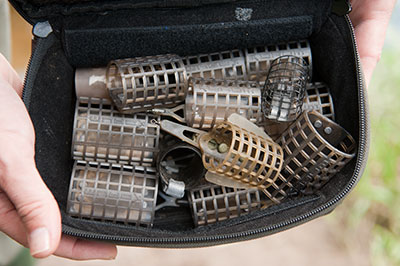
There are two ways we can go about making the line less noticeable. One way is to choose a line colour that blends with the bottom of the river, or at least the swim you’re fishing. Dark lines for over silt, light brown lines for over sand and gravel, green lines for in weed. But if we’re going to follow that route then we have to make sure the line is pinned to the bottom and not hung in mid-water or thereabouts like a washing line. Which means using a back-lead, which is a good idea anyway in many river swims even when the water is coloured. I use a flying back-lead which, even at very short range, pins the line down a good two feet back from the end tackle.
The second way is to use a clear line which, in theory at least, will show the colour of whatever bottom it’s lying on or close to. Theory or not it is my personal preference. I take the precaution of taking the stark gloss off the line though by rubbing it with damp, fine soil. Better still is to give a good rub with the fly fisher’s Fuller’s Earth which will not only take the shine off the line but help it sink.
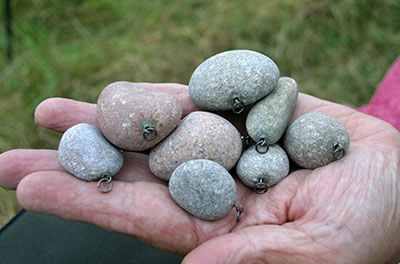 Objects of similar size and shape as hooks lie on riverbeds in abundance, so although I don’t think the hook will scare fish (the sight of it, not the feel of it) I don’t use silver and gold hooks, sticking to matt finish grey ones, such as the Korum Seamless.
Objects of similar size and shape as hooks lie on riverbeds in abundance, so although I don’t think the hook will scare fish (the sight of it, not the feel of it) I don’t use silver and gold hooks, sticking to matt finish grey ones, such as the Korum Seamless.
Weights and feeders are overlooked by too many anglers as potential fish-scaring items. Best to use leads that have been coated to match the bottom; there are some around these days that look like stones, in fact some, Stonze, really are stones, and you can’t get more natural than that. As for round plastic cylinders with holes in them, namely swimfeeders, then they must be as far from being natural as you can get, but at least use green or brown ones, and whatever you use, couple it with a good long hook link, preferably in fluorocarbon, that will lie on the bottom and be less visble to the fish.
Baits and Baiting
A particle bait like maggot or caster, used in combination with hemp, will often work in clear water when big baits are ignored. Particle baits trickled through a swim are much less likely to arouse suspicion than a great lump of luncheon meat bouncing through or lay there starkly pink and overly obvious. The best bigger baits are boilies, pellets and pastes when fishing clear water, which should be of a subtle, dull colour ranging through various shades of brown. Of course, none of this means that brightly coloured boilies, pink luncheon meat and bright yellow sweetcorn won’t work at all, just that subtle colours may not deter that particularly wary big fish that normally you have to wait until the dark hours to stand a chance of tempting.
Feeding the swim is best done before you actually fish, preferably with a mixture of particles such as hempseed and pellets. Where it’s possible they should be fed with a bait-dropper an hour or so before you introduce a hookbait. Baiting and then leaving a swim while the fish move in and begin to feed confidently is always a good idea, whatever the colour of the water.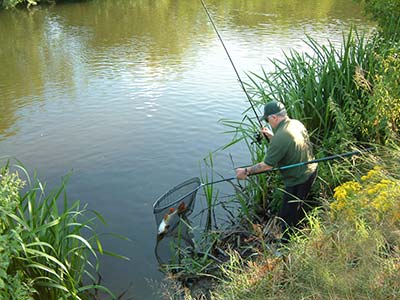
When this is not feasible, due to time restraints or the possibility of someone jumping the swim while you wait for it to mature, you need to be very careful how you feed. Again, a particle approach, just trickling bait in without causing a great deal of disturbance, is probably best. Otherwise, what I do when fishing a near-bank swim, is wrap some Method mix, made from soaked trout pellets and crumbled boilies, around a camouflaged lead or Stonze, and lower this into the swim. When the mix breaks down you’re left with a very subtle rig that is least likely to spook the fish.
So, don’t think it’s a waste of time fishing in daylight when the rivers run clear. There’s a lot you can do to ensure you get a fish or two. It all boils down to keeping a low profile with everything – yourself, your tackle and your bait.










